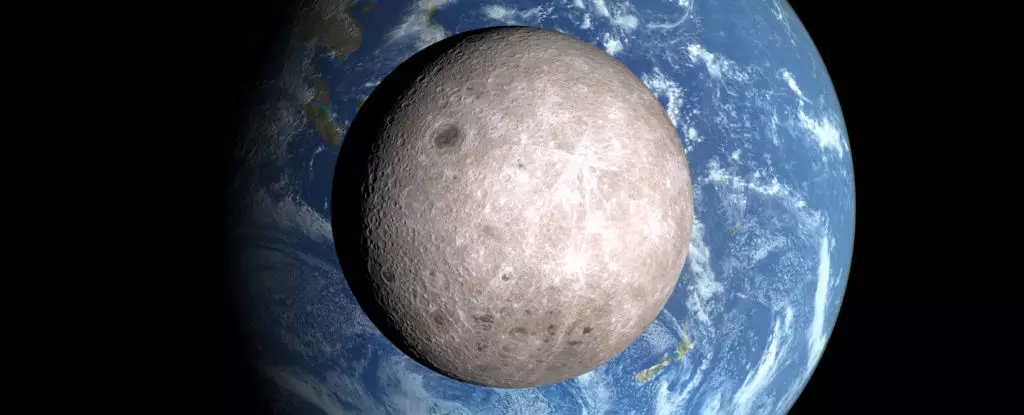Pioneering scientific research has unveiled a captivating enigma surrounding the Moon’s water distribution, revealing a significant asymmetry between its near and far sides. This discrepancy raises pertinent questions regarding the Moon’s geological history and the origins of its peculiar structure. Through the lens of new lunar material analysis, scientists are beginning to piece together a narrative that suggests a complex interplay of cosmic events leading to the Moon’s current state.
The Astounding Discovery of Water Distribution
Recent analysis of samples collected from the far side of the Moon, specifically the South Pole-Aitken Basin, has illuminated the stark differences in water content between the two hemispheres. While the near side boasts large basaltic plains known as maria—formed from extensive volcanic activity—the far side is characterized by rugged, heavily cratered terrain with a surprisingly low water presence. This raises the tantalizing question of how and why such a celestial body, formed in the same cosmic event, could exhibit such contrasting characteristics.
The implications of these findings extend beyond mere curiosity. As lunar physicists Huicun He and Linxi Li highlight, understanding water distribution in the lunar mantle is pivotal for reshaping our theories on the Moon’s origins. Water is not just a component; it serves as a critical element that elucidates the processes of crystallization within the lunar magma ocean, impacting the Moon’s volcanic activity and subsequent evolution.
A Giant Collision and its Ferocious Aftermath
The dominant theory surrounding the Moon’s formation is rooted in a cataclysmic event that occurred over 4.5 billion years ago. This hypothesis posits that a Mars-sized planetesimal, dubbed ‘Theia,’ collided with the early Earth, ejecting debris that eventually coalesced to form the Moon. Initially molten, the Moon’s surface gradually solidified, leading to the development of the maria that grace its near side.
This volcanic activity, however, was not uniform across the lunar surface. The current evidence suggests that the near side’s crust is considerably thinner, facilitating the rise and flow of molten rock. In contrast, the thicker crust on the far side may have inhibited volcanic activity and, subsequently, water retention, resulting in the stark visual and compositional differences observed today.
The significance of these geological disparities cannot be overstated. They signify the Moon’s history of uneven cooling and the influence of Earth’s gravitational pull during the formative years of both celestial bodies. This hypothesis, however, is still subject to investigation as scientists delve deeper into the composition of the Moon’s far side.
Insights from Chang’e-6: A Catalyst for Lunar Examination
The Chang’e-6 mission, a milestone in lunar exploration, has provided vital samples for studying the chemical makeup of the Moon’s far side. The findings from this mission are instrumental in assessing the previously hypothesized connections between lunar water distribution and the giant impact formation theory. By closely analyzing mineral samples such as olivine and ilmenite, researchers have established a fascinating baseline for understanding hydration levels in lunar basalt.
The results indicated a remarkably low water content in the South Pole-Aitken Basin, averaging about 1 to 1.5 micrograms per gram of rock. Such figures starkly contrast with the higher water levels recorded in certain regions of the near side, as previous studies indicated water concentrations could range from 1 to 200 micrograms per gram. This emerging picture of the Moon’s heterogeneous interior has the potential to reshape our understanding of the planetary formation process.
The Role of Future Research in Unveiling the Moon’s Secrets
The current findings present an intriguing challenge to established theories but also underscore the importance of continued lunar research. There is a need for additional samples from various far-side locations to garner a more comprehensive understanding of the Moon’s hidden reservoirs of water and their implications for our theories regarding lunar evolution.
The potential existence of wetter regions within the Moon’s far side may further complicate existing models of its formation and development. As scientists continue to refine their hypotheses and improve their methodologies, each sample from the lunar surface will contribute to a more nuanced understanding of how the Moon came to be.
In this thrilling era of lunar exploration, where ground-breaking discoveries are waiting to be made, the quest for answers regarding the Moon’s geological history is more crucial than ever. The Moon, a timeless wanderer in Earth’s night sky, holds secrets that can significantly enhance our understanding of planetary formation and the intricate processes that govern celestial bodies. As we hurl ourselves into this cosmic inquiry, the next chapters of lunar exploration promise to be of great scientific enthusiasm and profound importance.

